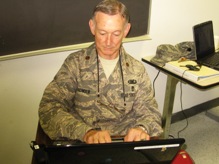The “Third Branch” Contributes to Newly Established Behavioral Health Services
Lt Col Greg Perry, 136th Airlift Wing, TXANG
2008/08/12
 Maj Richard Chaumier (TXSG, TMB) led the Behavioral Health Services at the Besteiro Middle School in Brownsville, Texas during OLS 08Photo by Photo by CPT J. Michael Spraggins PAO TXSG TMF
Maj Richard Chaumier (TXSG, TMB) led the Behavioral Health Services at the Besteiro Middle School in Brownsville, Texas during OLS 08Photo by Photo by CPT J. Michael Spraggins PAO TXSG TMF
Being a member of the Texas Air Guard, we sometimes feel overshadowed by the shear numbers of the Texas Army National Guard. So, I can only imagine the struggle it is for the Texas State Guard to be heard and find ways to contribute to the mission and capabilities of the Texas Military Forces. The Texas State Guard (TXSG) is one of three branches of the military forces that report to the Texas Adjutant General; they bring unique challenges and amazing attributes to the Texas Military Forces. The most glaring attribute is the truest spirit of volunteerism—except for rare circumstances like Operation Lone Star and being activated for disaster response operations like Hurricane Dolly, the members of the TXSG are pure volunteers. They give of their time, and yes even of their pocketbook, just to train, prepare and serve the citizens of the State of Texas.
Nowhere was this spirit of volunteerism more evident than the officer in charge of Behavioral Health Services at the Besteiro Middle School in Brownsville, Texas, this past week. Maj Richard Chaumier (TXSG) led the Behavioral Health Services that included Capt Allen Rush (TXSG), Capt Jeri Gates (TXARNG) and SSgt JoAnn Alonzo (TXARNG). Maj Chaumier boasted that he and his staff were rarely seen without “a smile on their faces”.
Some might question this abundance of good cheer while working long days in an improvised treatment facility away from home...it just might make you question the state of mind of the Behavioral Health staff. However, when you visit with them, you quickly learn that their smiles serve two purposes. First, it’s the sincere expression of satisfaction from helping people--both the citizens of south Texas and their fellow members of the Texas Military Forces. Capt Rush put it plain enough about Operation Lone Star when he said, “We love doin’ this!” Second, smiles are a small but effective form of preventative care—worker stress levels are lower if people are smiling or even cracking jokes. The same holds true for those receiving care: every smiling face from the first greeting at the edge of the parking lot to the last person in the check-out process made a difference in what could be a very daunting experience for children and adults alike. Maj Chaumier believed it was part of their mission to “roam the hallways wearing out shoe leather” just to play with kids or check up on the caregivers.
Behavioral Health staff did more than smile and play with the children. Maj Chaumier was quick to point out that Lone Star was not the place to begin treatment for those in the local populace suffering from life’s stresses or signs of depression. However, being co-located with the Chaplain staff and the local community resources functions was ideal for referring citizens to resources they might have otherwise never considered.
When asked to provide an example of the value Behavioral Health brought to Lone Star, Capt Gates told us about a sole-provider mother with children referred to Behavioral Health by the medical screening staff. This mother was the eldest of her siblings whose father had died a few years back. This mother lacked what we all need—a support system. Capt Gates explained that the mother expressed relief just from her short visit—it gave her a rare opportunity to talk about her loss without the concern of burdening her younger siblings or children. Capt Gates was successful in referring this patient to local mental health resources and, hopefully, the positive experience at Lone Star will make her more likely to avail herself of those resources. Capt Gates explained that it is common for many of us to need reassurance that our reactions to stress and loss are “normal”.
Maj Chaumier said it was by chance that SSgt Alonzo brought her invaluable experience to his section. SSgt Alonzo was assigned to Behavioral Health as a translator, but she also brought years of experience from her civilian employment working in Child Protective Services. Maj Chaumier bragged about SSgt Alonzo’s interactions with both children and adults.
Colonel Marco Coppola (TXARNG) was happy to have Behavioral Health as an established section in his “Lone Star Treatment Facility” and equally pleased on how seamlessly the TXSG and TXARNG members blended together. He told Maj Chaumier in his morning staff meeting that the TXSG was welcome back next year and the only thing he wanted to change was to ensure the TXSG was billeted at the same location as his TXARNG members.